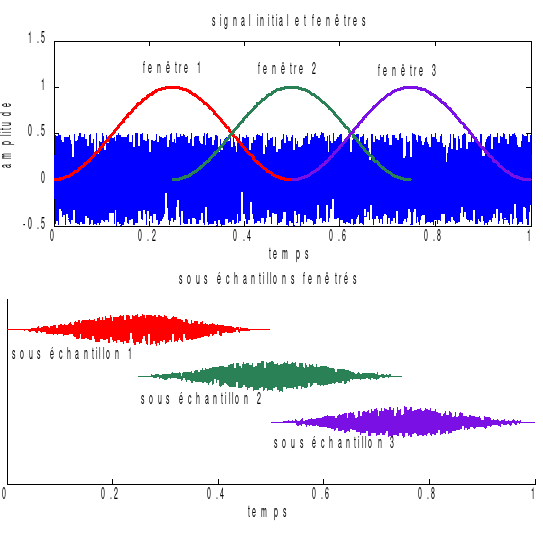3. Key words#
3.1. Keyword TAB_ECHANT#
Define the function table of the time samples and the associated signal processing parameters. Cannot be associated with the keyword ECHANT.
3.1.1. Keyword NOM_TAB#
Name of the table_function in which the samples are stored. Only one table_function name can be specified as input to perform calculations.
The functions stored in the table_function correspond to the results of measurements, true or simulated, which serve as the basis for calculating the spectral density matrix. All functions stored in the function_table must be defined with the same sample rate.
NB: The function_table must associate an order number and a measurement number with each function (see sections 3.2.2 and 3.2.3 for the meaning of these parameters)
3.1.3. Keyword RECOUVREMENT_DUREE/RECOUVREMENT_POURCENT/RECOUVREMENT_NB_PTS#
Define the length of overlap between two subsamples that will be used for signal processing. If the keyword is not entered, there is no overlap, the initial sample corresponds to the juxtaposition of the sub-samples. This length can be specified in three different ways:
RECOUVREMENT_DUREE: We define the length of the samples by their duration, expressed in the same unit as that used for the vector defining the moments.
RECOUVREMENT_POURCENT: Sample length is defined as a percentage of total length.
RECOUVREMENT_NB_PTS: We define the length of the samples based on the number of points we want to remember.
The figure illustrates the division and fenestration of an initial sample into fenestrated sub-samples.

Figure 3.1.3-1 : illustration of the cutting and fenestering of an initial sample. The window applied is of the Hanning type, with an overlap of 50% between the sub-samples.
3.2. Keyword ECHANT#
Key word factor where the functions used for signal processing are defined. Cannot be used in conjunction with the TAB_ECH keyword
3.2.1. Keyword FONCTION#
Name of the function containing the time sample.
3.2.2. Keyword NUME_ORDRE_I#
Defines the serial number of the time sample (for example, a sensor number, measurement channel, or point number on a mesh). This mandatory keyword is used to identify interspectra or transfers in the interspectrum concept (result).
3.2.3. Keyword NUME_MES#
Define the measurement number for the sample. This mandatory keyword is used to identify the measurements that would be carried out simultaneously, or with the same phase reference, in order for the averaging of the spectra to be legal. If two samples have the same measurement number, it means that they were acquired simultaneously. It is then possible to perform interspectra and transfer functions from one to the other. In another case, this is impossible, due to the absence of a phase reference between the two signals.
3.3. Keyword INTERSPEC#
Calculate the spectral density matrix (or inter-spectral) from the temporal samples provided.
3.3.1. Keyword FENETRE#
Defines the type of window to be applied to the time sample. The size of the window is adapted to the length of the sample or sub-samples, depending on the case being treated. Key word to choose from:
RECT: Define a rectangular window on the sample.
HAMM: Define a Hamming window.
HANN: Define a Hanning window.
EXPO: Define a decreasing exponential window. You must then enter the keyword DEFI_FENE.
PART: Allows the user to define their window based on a list of real numbers given in the DEFI_FENE keyword. The list must be of the same length as the samples or sub-samples considered.
3.3.2. Keyword DEFI_FENE#
Allows the user to provide the required information when the FENETRE keyword takes the values” EXPO “or” PART “.
“EXPO”: The list consists of exactly two values. The first corresponds to the number of points for which the window takes the value 1. The second corresponds to the slope of the exponential at the origin. These two quantities are illustrated in the figure.
“PART”: The window is defined by a list of actual entries entered by the user.

Figure 3.3.2-1 : Definition of the parameters of DEFI_FENE: width (in number of points) of the initial plateau, and slope at the origin of the exponential.
3.4. Keyword TRANSFERT#
Calculate transfer functions based on the time samples provided.
3.4.1. Keyword ESTIM#
Define the estimator to be used for calculating transfer functions. To choose from:
H1: Use estimator \(\mathrm{H1}\)
H2: Use estimator \(\mathrm{H2}\).
CO: Calculate the consistency between estimators \(\mathrm{H1}\) and \(\mathrm{H2}\).
As a reminder, if two signals \(A\) and \(B\) are available, the estimator \(\mathrm{H1}\) of the transfer function \(A/B\) is defined by:
\(\mathrm{H1}(A/B)={G}_{\mathrm{AB}}/{G}_{\mathrm{BB}}\),
And the estimator \(\mathrm{H2}\) by:
\(\mathrm{H2}(A/B)={G}_{\mathrm{AA}}/{G}_{\mathrm{AB}}\),
Where \({G}_{\mathrm{AB}}\) is the interspectrum between signals \(A\) and \(B\). Consistency is defined by:
\(\mathrm{CO}(A/B)=\mid \mathrm{H1}/\mathrm{H2}\mid\).
The estimator \(\mathrm{H1}\) minimizes the influence of noise on the measured outputs, and \(\mathrm{H2}\) minimizes the influence of noises that may appear on the input measurements.
3.4.2. Keyword REFER#
List of integers that define the reference measures for calculating transfers. The integers used correspond to the order numbers of the time samples.
3.4.3. Keyword FENETRE#
Defines the type of window to be applied to the time sample. See section 3.3.1.
3.4.4. Keyword DEFI_FENE#
Allows the user to provide the required information when the FENETRE keyword takes the values” EXPO “or” PART “. See section 3.3.2.
3.5. Keyword TITRE#
Defines the title associated with the cross-spectrum data structure where the results are stored.